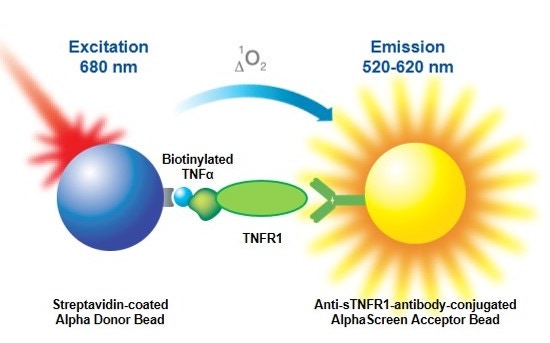
Overview
Ligand:receptor assays can be designed to measure the direct interaction of a ligand and a receptor, or a functional response triggered through agonist-mediated receptor activation. Direct ligand-binding can be studied using a recombinant, soluble portion of your receptor in biochemical assay. Cell surface receptors as well as nuclear receptors can be studied. We offer many types of beads as standard catalog products that can be used to bind to an antibody specific for your receptor, or to His-tagged, c-myc-tagged, GST-tagged, or biotinylated receptors, etc. We offer unconjugated beads that can be used to directly-conjugate any molecule of interest (for example, an antibody) to a bead. We also offer AlphaLISA™ binding kits for several targets, as well as custom bead conjugation services.

Figure 1. Example of the assay design for a TNFα ligand-TNFα receptor binding assay.
You could also design your assay to measure the functional response of the receptor upon activation by the ligand. For a functional assay, we offer the AlphaScreenTM cAMP kit as well as our Alpha SureFire® kits. The AlphaScreen cAMP kit measures the activation of Gi-coupled or Gs-coupled GPCRs by measuring changes in levels of cellular cAMP. The Alpha SureFire® assays can be used to measure downstream signaling events (phosphorylation of targets involved in various signaling cascades), following stimulation of a cell-surface receptor. Both these are cell-based assays that involve cell lysis. If you are interested in either of these functional assays, please view the AlphaScreen cAMP or Alpha SureFire® pages for more information.
What do I need to run this assay?
For direct ligand-receptor binding assays, the following list includes required reagents available from Revvity:
- Alpha Donor beads (that can associate with one of the binding partners, either the ligand or the receptor)
- AlphaScreen or AlphaLISA Acceptor beads (that can associate with the other binding partner)
- Microplates - We recommend our 96-well 1/2 AreaPlates or our 384-well white OptiPlates™. Also see Microplate selection.
- TopSeal™-A adhesive plate seal for incubations
Instrumentation/equipment:
- A plate reader capable of reading Alpha assays
Assay development
For detailed information on assay design and development, view our Create your own Alpha assay page.
Citations
View a brief list of citations for Alpha ligand-receptor assays.
Tips and FAQs
Information on determining a Kd in Alpha format.
Q. Can I bind a cell membrane to a bead? If so, what is the best way to do this?
A. You will need to test this for your particular assay. We have captured membranes for Alpha assays using lectin-coated beads (wheat germ agglutinin, concanavalin A, etc.). We can custom conjugate beads to be coated with WGA and ConA.
Q. Can I work with tissues or crude membrane preparations?
A. You will need to test this for your particular assay. We have used lectin-coated beads in the past to capture membrane. You may also be able to tag or biotinylate your membrane and use an appropriate affinity bead to capture your tissue.
Troubleshooting
View our general Alpha troubleshooting tips.
For research use only. Not for use in diagnostic procedures.
The information provided above is solely for informational and research purposes only. Revvity assumes no liability or responsibility for any injuries, losses, or damages resulting from the use or misuse of the provided information, and Revvity assumes no liability for any outcomes resulting from the use or misuse of any recommendations. The information is provided on an "as is" basis without warranties of any kind. Users are responsible for determining the suitability of any recommendations for the user’s particular research. Any recommendations provided by Revvity should not be considered a substitute for a user’s own professional judgment.




























